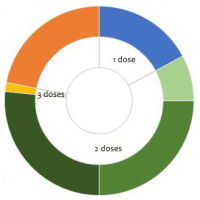Without a national and coordinated response to COVID-19, the United States has been ineffective at preventing and mitigating the escalating pandemic. What the country needs, according to new research (Post et al. 2020), is a dynamic public health surveillance to better inform prevention efforts.
You might also like:COVID-19: Immunity-Based Strategies are ‘Flawed’
Dynamic surveillance can help government and health authorities in the country to shift "from reacting to COVID-19 transmissions to being proactive and taking corrective action" as needed, according to the study that proposes new "surveillance metrics" for analysing the relevant dynamics of the pandemic. Current standard surveillance metrics (e.g. daily and cumulative infections and deaths) provide a static view of what has already occurred in the pandemic and are less helpful in prevention.
The new dynamic surveillance metrics or indicators proposed by the study are speed, acceleration, jerk, and persistence. According to study authors, large positive acceleration and jerk as well as persistence are indicative of explosive growth in a practical sense (i.e. the COVID-19 caseload is expected to increase much more rapidly than in the current or recent week).
In this study, the authors examined these indicators week over week for seven weeks along with the daily caseload. COVID-19 data for this study were extracted from global public health registries. The authors used an empirical difference equation to measure daily case numbers for all 50 U.S. states and the District of Colombia as a function of the prior number of cases, the level of testing, and weekly shift variables that measure whether the contagion was growing faster, the same, or slower than the previous weeks. This resulted in a dynamic panel model that was estimated using the generalised method of moments approach by implementing the Arellano-Bond estimator in R (The R Foundation for Statistical Computing).
Overall, most American states are experiencing outbreaks as measured by these new metrics of speed, acceleration, jerk and persistence.
Other important findings of the study include:
- Larger U.S. states have high COVID-19 caseloads as a function of population size, density and deficits in adherence to public health guidelines early in the epidemic.
- Some states have alarming rates of speed, acceleration, jerk, and 7-day persistence in new infections.
- North and South Dakota have had the highest rates of COVID-19 transmission combined with positive acceleration, jerk, and 7-day persistence.
- California and Pennsylvania have positive speed, acceleration, jerk, and persistence, suggesting the outbreak in these two populous states will be significant in terms of caseload.
Dynamic public health surveillance, according to the authors, is necessary to inform specific geographies where quarantines are necessary while preserving the economy in other U.S. areas.
"Implicit within our dynamic surveillance is an early
warning system that indicates when there is problematic growth in COVID-19
transmissions as well as signals when growth will become explosive without
action," the authors explain. "Moreover, subnational analyses on the
dynamics of the pandemic allow us to zero in on where transmissions are
increasing, meaning corrective action can be applied with precision in
problematic areas.”
Image credit: Lyubov Ivanova via iStock



























